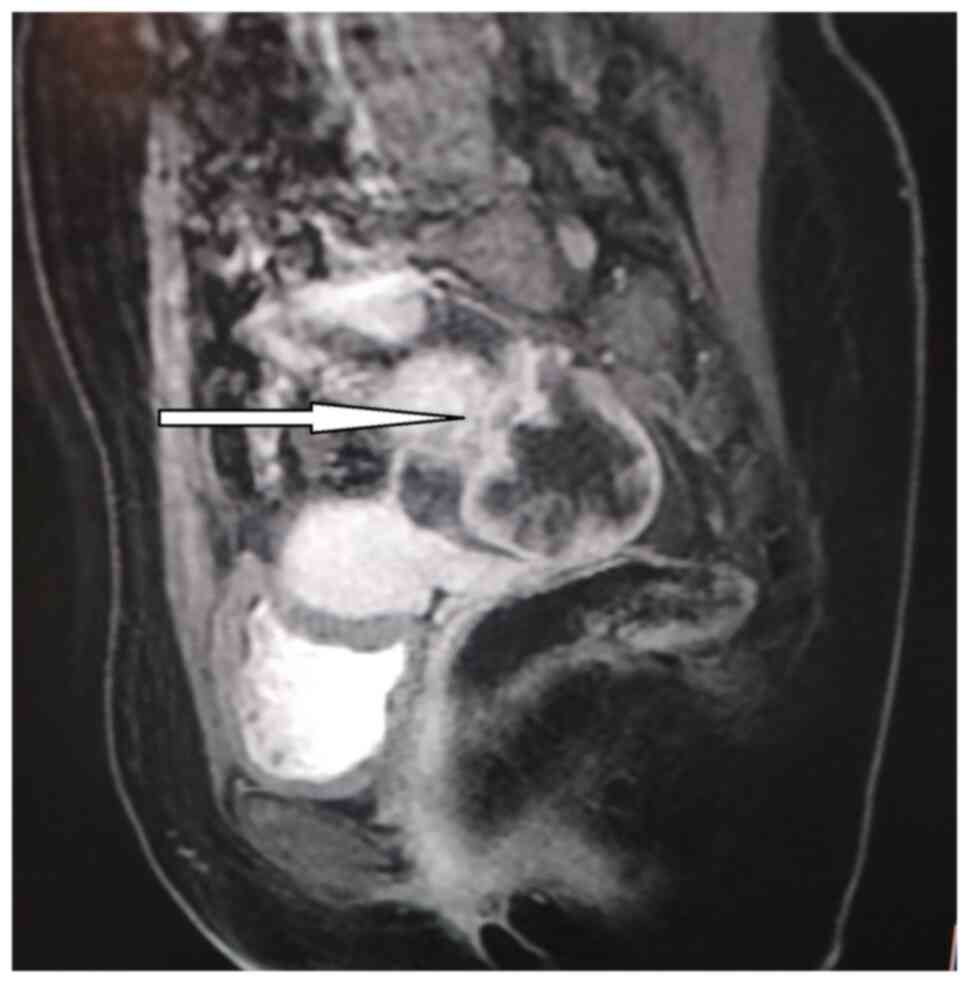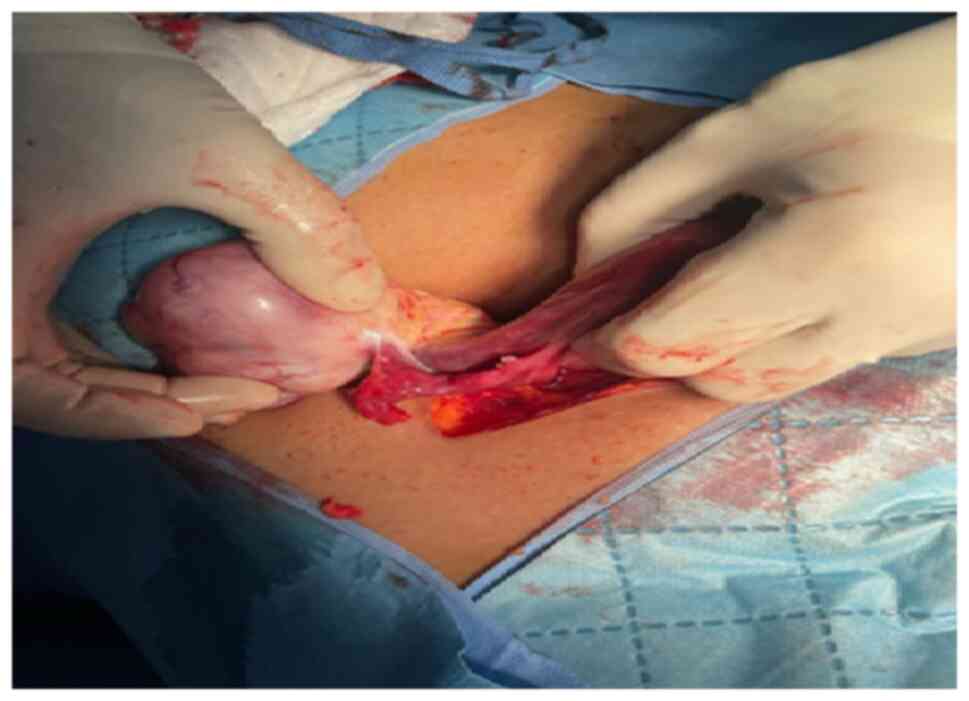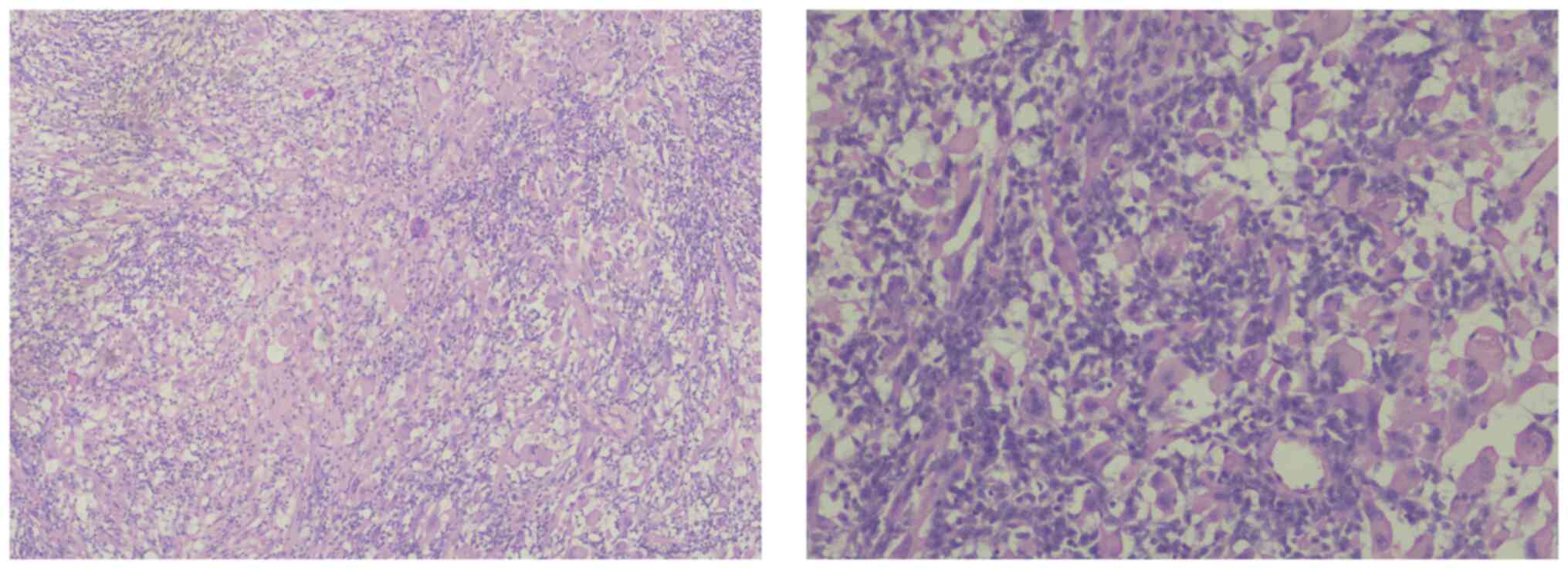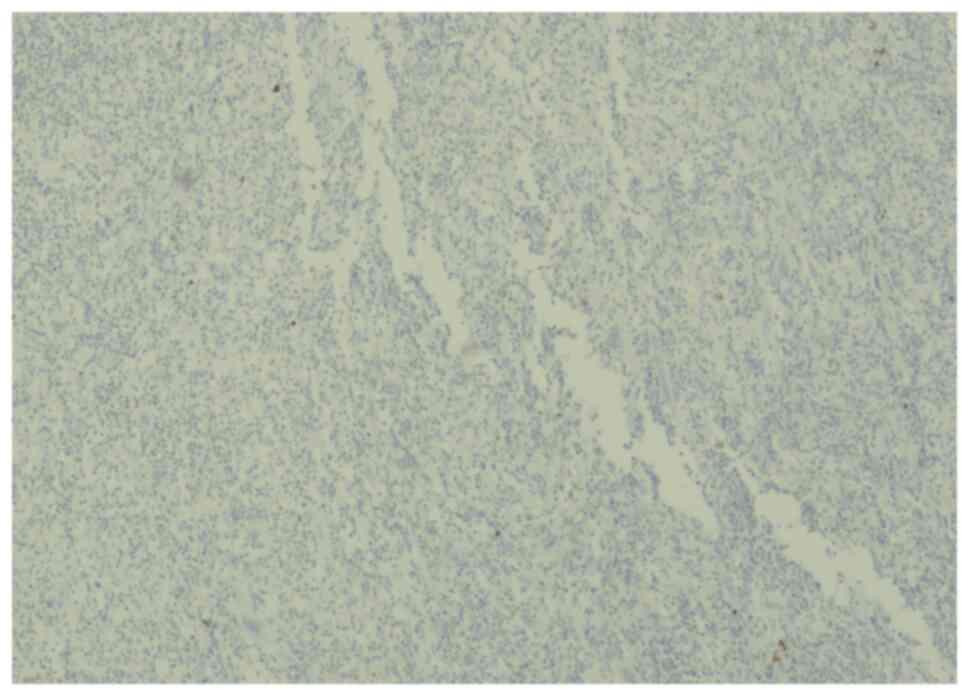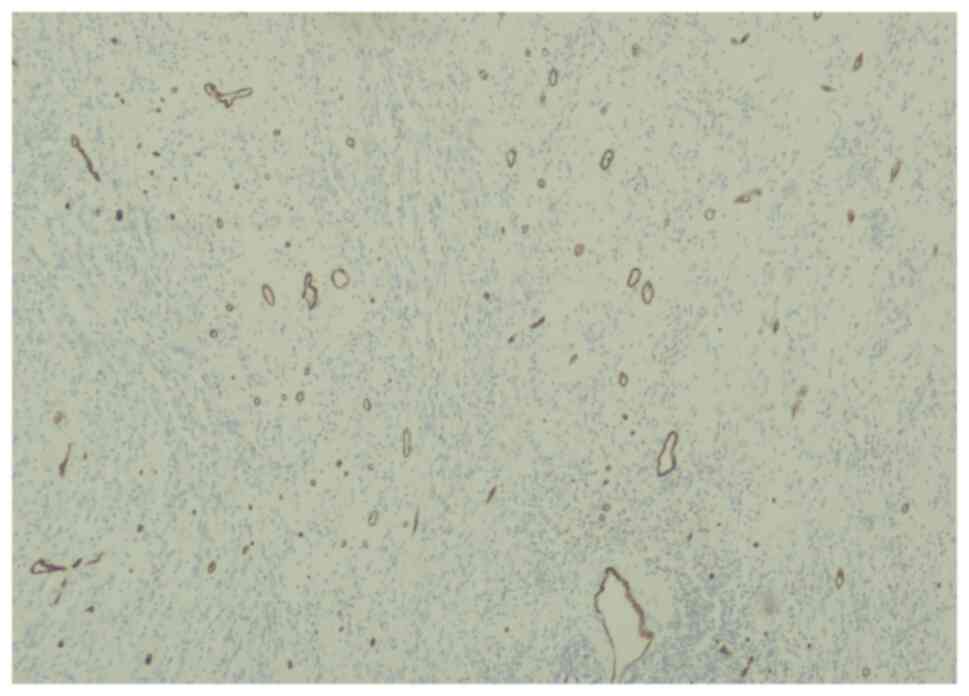Rare histopathological finding of ovarian pseudotumor: A case report
- Authors:
- Published online on: March 19, 2024 https://doi.org/10.3892/br.2024.1767
- Article Number: 79
-
Copyright: © Samara et al. This is an open access article distributed under the terms of Creative Commons Attribution License.
Abstract
Introduction
An inflammatory pseudotumor (IPT) is a benign, rare chronic inflammatory process that most frequently affects the lung and orbits as an extrapulmonary site but can occur in almost any organ in the body such as pelvic organs (1). Its occurrence in the pelvis is rare with only two cases being reported (2,3). IPTs typically follow a benign clinical course, with 25% rate of local recurrence (4). While IPT may occur in any age group, more than half of the cases occur in patients aged 30-49 years with peak age of 38.9 years and female predominance (5).
The origin of IPT is not known, but various mechanisms have been suggested including immune-autoimmune, trauma and surgical inflammation (6), furthermore, it may resemble low-grade fibrosarcoma with inflammatory cells (6).
IPT may develop as the result of an infection linked to different pathogens at different body sites, such as mycoplasmata and Nocardiae in the lungs, actinomycetes in the liver, Epstein-Barr virus in the spleen and mycobacteria in spindle cell tumors (1). The diagnosis of IPT is difficult as it is typically made by exclusion based on the histopathological findings (1). For the majority of IPT, the preferred treatment is surgical resection (7).
Case report
A 39-year-old healthy female patient with hypothyroidism and no previous surgical operations or sexual activity presented to Dr Ismaiel Abu Mahfouz gynaecology clinic in The Specialty Hospital (Amman, Jordan) in January 2023 with mild lower abdominal pain. Ultrasound examination showed a complex right sided ovarian cyst measuring 6.0x6.5 cm. There was no evidence of free fluid in the pelvis, and the left ovary and uterus were unremarkable. Pelvic magnetic resonance imaging (MRI) and ovarian tumor marker assessment (cancer antigen 125 and 19-9, carcinoembryonic antigen, and beta subunit of human chorionic gonadotropin) was requested to rule out malignancy. MRI confirmed the presence of a complex cystic lesion mostly arising from the right ovary and extending posteriorly, measuring ~6.5x5.6 cm and having a thick nodular enhancing wall with thin enhancing septations. The uterus was of normal size with no focal lesion; no other solid masses could be seen in the pelvis and there was a small amount of free fluid seen in the pelvis and no recognized pelvic adenopathy (Fig. 1).
Tumor markers showed CA-125 was 30 (normal range: 0-35 units/ml), cancer antigen 19-9 was 6 (normal range 0-37 units/ml), carcinoembryonic antigen was 0.9 (normal range 0-2.5 ng/ml), beta subunit of human chorionic gonadotropin was negative and lactate Dehydrogenase was 27 (normal range 105-333 IU/L) (8).
Considering the complex nature of the cyst and after counselling, a low transverse laparotomy was performed in January 2023 at The Specialty Hospital, Amman Jordan. The findings during laparotomy showed a right ovarian mass measuring ~7x8 cm (Fig. 2). The uterus and left ovary looked normal and there was a small amount of serous free fluid in the pelvis. The peritoneal fluid was aspirated, and a right ovarian cystectomy was performed along with left ovarian, peritoneal and omental biopsies.
The histopathology techniques were as follows: Dehydration by ethanol from 70 to 100%, Clearing by xylene, Impregnation using wax 52-56˚C. Paraffin embedding was at 65˚C for 16 h A section Thickness was 5 micron. BenchMark GX, VENTANA) with ready-to-use made antibodies was used for antibody dilution. For detection and counter-stain hematoxylin was used and viewed under a light microscope.
The histopathology of the right ovarian cyst showed fibrovascular core (hemangiopericytoma-like) infiltrate by mononuclear chronic inflammatory cells with histiocytes and numerous multinucleated giant cells. The infiltrate was in a diffuse pattern with perivascular cuffing, myxoid degeneration, fibrinoid material and hyalinized fibrosis (Fig. 3).
The lesion was immunoreactive for vimentin (Fig. 4) but not reactive for actin (Fig. 5), positively stained for S100 (Fig. 6), CD34 (Fig. 7) and CD68 (Fig. 8), highlighting the histiocytes. Ki-67 proliferating index was high >20% (Fig. 9). The overall pathology and immune results indicated IPT. While the results of peritoneal fluid cytology was negative for malignant cells; there were hyperplastic mesothelial cells and macrophages with rare inflammatory exudate. Additionally, peritoneal and omental biopsies were normal. The patient was uneventfully followed up till September 2023.
Discussion
IPT is rarely seen in the pelvis. To the best of our knowledge, there are few reported cases of IPT affecting the female reproductive system (2,9). The patient in our case report was found to have ovarian inflammatory pseudotumor.
Here, the patient presented with mild lower abdominal pain and was diagnosed with IPT. Patients in these cases may present with symptoms associated with mass effect or with non-specific symptoms and signs of inflammation such as fever, weight loss, and abdominal pain (1).
There are no specific characteristic features for IPT on imaging studies (1). The present MRI findings showed features of a complex cystic ovarian tumor with a thick wall and enhancing septation, which were non-specific (1,7). The lack of specific radiological characteristics may be related to the degree of fibrosis and cellular infiltration, where lesions may seem hypoechoic or hyperechoic with ill-defined or well-circumscribed boundaries on ultrasound images. These lesions frequently have more vascularity in the Doppler test (1).
A homogenous or heterogeneous lesion may be visible on contrast-enhanced MRI scan, and in the presence of fibrosis, more enhancement may be demonstrated with delayed MRI images (1). Diagnosis of IPT depends on histopathological studies, which may show myofibroblasts and mixed inflammatory and spindle-shaped cells (plasma cells, lymphocytes and, sporadically, histiocytes) (10). Furthermore, IPT may be misdiagnosed as low-grade fibrosarcoma. Histopathological features differentiating these are seen in low grade fibrosarcoma and include the presence of atypia (3,11). Here, immunostaining for vimentin was positive and negative for actin and the Ki 67 proliferation index was 20% (11). The IPT was surgically removed for both diagnosis and treatment. The prognosis of the disease is still unknown and there is risk of recurrence (2,12).
In conclusion, IPT can arise from the ovary, with no pathognomonic features on the imaging. In addition, it is rare and may not be easily diagnosed on histopathological studies as it may resemble low grade fibrosarcoma. Surgical resection is the most common therapy.
Acknowledgements
Not applicable.
Funding
Funding: No funding was received.
Availability of data and materials
The data generated in the present study are included in the figures and/or tables of this article.
Authors' contributions
BS, SS, AAB, RI, AA and IAM performed clinical management and surgery. AAB and RI collected clinical data, edited the manuscript and constructed figures. AA performed histopathological experiments and wrote the manuscript. IAM and AA confirm the authenticity of all the raw data. All authors have read and approved the final manuscript.
Ethics approval and consent to participate
Not applicable.
Patient consent for publication
Written informed consent was obtained from the patient for publication of this case report and any accompanying images.
Competing interests
The authors declare that they have no competing interests.
References
|
Patnana M, Sevrukov AB, Elsayes KM, Viswanathan C, Lubner M and Menias CO: Inflammatory pseudotumor: The great mimicker. AJR Am J Roentgenol. 198:W217–W227. 2012.PubMed/NCBI View Article : Google Scholar | |
|
Stolnicu S and Soslow RA: Inflammatory pseudotumor presenting as a mesosalpingeal mass. Int J Gynecol Pathol. 37:473–476. 2018.PubMed/NCBI View Article : Google Scholar | |
|
Sun TT, Cheng NH, Cao DY and Peng P: Ovarian fibrosarcoma: A single-institution experience and a review of the literature. J Ovarian Res. 13(142)2020.PubMed/NCBI View Article : Google Scholar | |
|
Gude D, Rayudu R and Bansal D: How pseudo is an inflammatory pseudotumor? Indian J Med Paediatr Oncol. 32:204–206. 2011.PubMed/NCBI View Article : Google Scholar | |
|
Ajani MA, Fatunla EO, Onakpoma FA and Salami AA: Inflammatory Pseudotumor: A 20-year single institutional experience. Adv Biomed Res. 9(68)2020.PubMed/NCBI View Article : Google Scholar | |
|
Fayad FT, Bezerra MCT, da Rosa MRP and Pinheiro TN: Diagnosis, treatment, and rehabilitation of a patient with inflammatory pseudotumor. Eur J Dent. 12:454–458. 2018.PubMed/NCBI View Article : Google Scholar | |
|
Sedlic T, Scali EP, Lee WK, Verma S and Chang SD: Inflammatory Pseudotumours in the Abdomen and Pelvis: A pictorial essay. Can Assoc Radiol J. 65:52–59. 2014.PubMed/NCBI View Article : Google Scholar | |
|
Perkins GL, Slater ED, Sanders GK and Prichard JG: Serum tumor markers. Am Fam Physician. 68:1075–1082. 2003.PubMed/NCBI | |
|
Gücer F, Altaner S, Mülayim N and Yapicier O: Invasive inflammatory pseudotumor of uterine cervix: A case report. Gynecol Oncol. 98:325–328. 2005.PubMed/NCBI View Article : Google Scholar | |
|
Ntinas A, Kardassis D, Miliaras D, Tsinoglou K, Dimitriades A and Vrochides D: Inflammatory pseudotumor of the liver: A case report and review of the literature. J Med Case Rep. 5(196)2011.PubMed/NCBI View Article : Google Scholar | |
|
Gultekin M, Dursun P, Ozyuncu O, Usubutun A, Yuce K and Ayhan A: Primary ovarian fibrosarcoma: A case report and review of the literature. Int J Gynecol Cancer. 15:1142–1147. 2005.PubMed/NCBI View Article : Google Scholar | |
|
Goto T, Akanabe K, Maeshima A and Kato R: Surgery for recurrent inflammatory pseudotumor of the lung. World J Surg Oncol. 9(133)2011.PubMed/NCBI View Article : Google Scholar |



